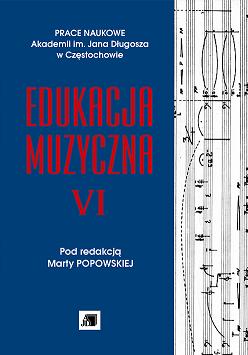Początki polskiej sonaty skrzypcowej
The Origins of Polish Violin Sonatas
Author(s): Maryla RenatSubject(s): Fine Arts / Performing Arts, Music
Published by: Uniwersytet Jana Długosza w Częstochowie
Keywords: polish violin sonatas
Summary/Abstract: The contents of the paper show precise analysis of three early Polish pieces of the violin sonata type: Sonata in D major for 2 violins and a basso continuo by Stanislav Sylvester Szarzyński, the only saved Polish trio sonata, Sonata in A-major for violins and basso continuo by Karol Ogiński (mid-18th century), and Sonatina in G major for violins and a harpsichord by Maciej Radziwill from the 2nd half of the 18th century. The article contains 4 sub-sections. The first sub-section is entitled “Remarks on Polish Baroque and Enlightenment Instrumental Music” and describes the historical background for the topics and provides information about research on the Polish native instrumental output of the 17th and 18th centuries. It appears from the remarks that Polish instrumental music in the abovementioned historical period was characterised by domination of dance forms. Source materials in the archives revealed that there were numerous examples of violin sonatas (Lilius, Mielczewski, Pękiel, Różycki), but the works were not preserved. The second sub-section is devoted to the Sonata in D major by S. S. Szarzyński. Following a short description of results of the research carried out so far on this work (ChybiĔski, Feicht, ChomiĔscy, Szelest), I present a detailed analysis of the successive parts of the composition. The formal analysis is complemented with remarks on the extent of violin technique and expression. The subject of the third sub-section is the Sonata in A major byKarol OgiĔski. It starts with remarks on the situation of Polish music in the middle of the 18th century and with a commentary on the conduct of researchers aimed at establishing the authorship of the sonata. The analysis of the composition includes analysis of the form, the sound language, construction of themes, appropriateness of expression. Eventually, I come to the conclusion that the Sonata in A-major is a piece typical for the transitory period between baroque and classicism, because in its musical prosody it contains distinctive baroque and early classicism features. The characteristics of the Sonatina in G-major by M. Radziwiáá in the fourth subsection is preceded by biographical information about the composer and remarks about the changes introduced into the piece by publishers. The analysis of the sonata follows the same pattern as in the preceding pieces. The characteristics is illustrated with examples of musical notation. The article is closed with a short summary. The final conclusion is that the scarce number of reference sources allows only partial determination of style of the pieces and their contribution to European violin oeuvre.
Journal: Edukacja Muzyczna
- Issue Year: 2011
- Issue No: 6
- Page Range: 11-34
- Page Count: 24
- Language: Polish

